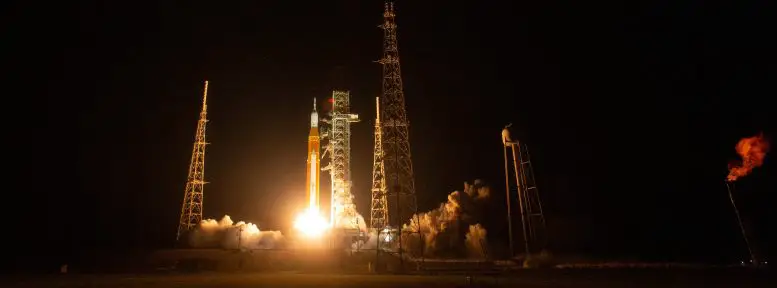NASA’nın Orion uzay aracını taşıyan Uzay Fırlatma Sistemi roketi, 16 Kasım 2022’de NASA’nın Florida’daki Kennedy Uzay Merkezi’ndeki Launch Complex 39B’den Artemis I uçuş testinde fırlatıldı. NASA’nın Artemis I misyonu, ajansın derin uzay keşif sistemlerinin ilk entegre uçuş testidir: Orion uzay aracı, Uzay Fırlatma Sistemi (SLS) roketi ve yer sistemleri. SLS ve Orion, Kennedy Uzay Merkezi’ndeki Fırlatma Pisti 39B’den 01:47 EST’de fırlatıldı. Kredi bilgileri: NASA/Joel Kowsky
SLS rocket met or exceeded all performance expectations, SLS engineers are now taking a closer look at the Moon rocket’s performance to prepare for the first crewed Artemis missions.
Building off the assessment conducted shortly after launch, the preliminary post-flight data indicates that all SLS systems performed exceptionally and that the designs are ready to support a crewed flight on Artemis II. The post-flight analysis team will continue reviewing data and conducting final reports.

The core stage of NASA’s Space Launch System (SLS) rocket has more than 1,000 sensors and 45 miles of cabling. The SLS core stage’s base heat shield is roughly 1.3 inches thick and was specially designed to protect the 212-foot-tall stage and its two liquid propellant tanks from launch pad temperatures greater than 3,200 degrees Fahrenheit. Data indicates the structure was not affected by temperatures that can turn sand to glass. Credit: NASA/Chris Coleman and Kevin Dav
“NASA’s Space Launch System rocket has laid the foundation for the Artemis Generation and the future of spaceflight in deep space,” said John Honeycutt, SLS Program manager. “The correlation between actual flight performance and predicted performance for Artemis I was excellent. There is engineering and an art to successfully building and launching a rocket, and the analysis on the SLS rocket’s inaugural flight puts NASA and its partners in a good position to power missions for Artemis II and beyond.”
Ahead of launch, teams established benchmarks for the rocket’s performance through a series of pre-flight simulations and test campaigns. As the rocket launched and ascended to space, it experienced dynamic phases, like extreme forces and temperatures, that influenced its operations. The Artemis I flight test was the only way to gather real data on how the rocket performed during events like booster separation.

Four RS-25 engines and two five-segment solid rocket boosters provide more than 8.8 million pounds of thrust for SLS during liftoff and flight. Thanks in part to the development of a new RS-25 engine controller that checks engine health 50 times per second, engineers were able to collect more than 100 measurements on pressures, temperatures, flows, speeds, and vibrations on the four RS-25 engines that helped power Artemis I. Credit: NASA/Joel Kowsky
Engineers in the SLS Engineering and Support Center at NASA’s Marshall Space Flight Center in Huntsville, Alabama, collected more than four terabytes of data and on-board imagery from SLS during pre-launch and launch phases. In addition, a total of roughly 31 terabytes of imagery data alone was collected from ground cameras, cameras on the rocket, and aerial cameras that were focused on SLS. By comparison the Library of Congress’ printed material is roughly 20 terabytes.
“The data we got back from Artemis I is critical in building confidence in this rocket to send humanity back to the Moon,” said John Blevins, SLS chief engineer. “The SLS team will use what we learn from this flight test to improve future flights of the rocket, and we are already taking what we’ve learned about operations and assembly and applying it to streamline future missions.”
Ay’a yolculuğunda motor ateşlemesinden Orion’un ayrılmasına kadar fırlattığım Artemis’i deneyimleyin. Kredi bilgileri: NASA
Kameralar ve sensörler ayrıca ekiplerin roketin uzay içi manevraları sırasında nasıl performans gösterdiğini izlemesine olanak sağladı. Fırlatmayı SLS roketinin “görünüşünden” görmek (yukarıdaki videoya bakın), roket, mobil fırlatıcı ve fırlatma rampası boyunca stratejik olarak kameraları, sensörleri ve diğer ölçüm araçlarını konumlandırmayı içeriyordu.
Beth St. Peter, SLS görüntü entegrasyon lideri.

NASA’nın Uzay Fırlatma Sistemi (SLS) roketi, Orion uzay aracının Ay’a ulaşmak için ihtiyaç duyduğu uzay içi “itmeyi” sağlayan ara kriyojenik tahrik aşaması (ICPS) ile aşamalı olarak itiş gücü sağlar. Artemis I sırasında ICPS, Orion’u Ay’a göndermek için tasarımın 50 yılı aşkın tarihindeki en uzun RL10 motor yanması ve yüzlerce görev dahil olmak üzere iki başarılı yakma gerçekleştirdi. Kredi bilgileri: NASA
Mühendisler ayrıca roketin kalkıştan hemen sonra yaşadığı aşırı sıcaklıkları ve sesleri de izledi. SLS uçuş sonrası verileri, RS-25 motorlarının itme ve karışım oranı kontrol valflerinin tahmin edilen değerlerin %0,5’i içinde olduğunu göstermiştir. Karışım oranı, sekiz dakikalık uçuş süresi boyunca motorlardan gelen sıcaklığı ve itişi belirleyen yakıtın oksitleyiciye oranıdır. Diğer önemli motor iç basınçları ve sıcaklıkları, uçuş öncesi tahmin edilen değerlerin %2’si içindeydi.
Uçuş sırasında, SLS çekirdek aşaması tüm işlevlerini başarıyla yerine getirdi ve ICPS ile Orion uzay aracını 972.1 mil x 16 mil’lik ilk Dünya yörüngesine yerleştirdi. Ek parça, 975 mil x 16 mil olan mükemmel hedeften sadece 4,9 mil çekingendi ve kabul edilebilir parametreler içindeydi. Neredeyse mükemmel bir trans-lunar enjeksiyon yanmasının ardından, ICPS ve Orion uzay aracı başarılı bir şekilde ayrıldı ve Orion’un 25,5 günlük bir görevi tamamlamasına izin verdi.
Artemis programının bir parçası olarak NASA, Ay’ın yüzeyine ilk kadın ve beyaz olmayan kişiyi iniş de dahil olmak üzere birçok dönüm noktasına ulaşmayı hedefliyor. Bu, uzun vadeli Ay varlığı için bir temel oluşturacak ve astronotlar için çok önemli bir basamak taşı görevi görecek. Mars.

